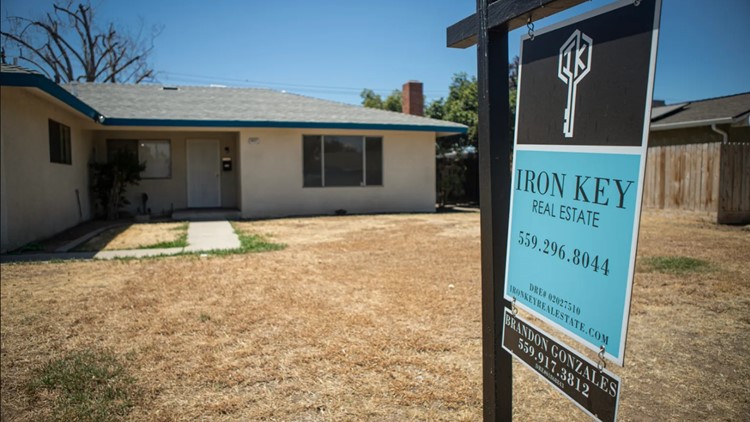CALIFORNIA, USA — This story was originally published by CalMatters.
In this economy, who has enough money for a down payment on a house?
Despite a projected $25 billion budget deficit, the state of California does. At least for now.
The California Housing Finance Agency is poised to launch a scaled-down version of its new shared equity home loan program on March 27. With the Dream for All program, the state plans to provide $300 million worth of down payments for an estimated 2,300 first-time homebuyers.
The complicated program involves the state paying some or all of the upfront costs for buying a home — the down payment, for instance — in exchange for a share in the home’s value when it is sold, refinanced or transferred.
If the home appreciates in value, those gains to the state would then be used to fund the next borrowers — a little for the seller; a little for the next aspiring buyer.
Everybody wins — as long as prices go up.
The trouble is that home prices have been declining in the state for months, even as higher mortgage interest rates have made monthly mortgage payments more expensive.
A potential economic downturn looms as well, as the Federal Reserve weighs raising borrowing costs even further as soon as today.
And California’s tech industry is taking a beating and laying off workers, contributing to a decline in personal incomes. Income taxes are the state’s biggest revenue source.
Given the uncertainty, Gov. Gavin Newsom in January proposed a significantly smaller version of the 10-year, $10 billion program originally envisioned by Senate President Pro Tem Toni Atkins, a Democrat from San Diego. In his January budget, Newsom proposed spending an initial $300 million on the program, a cut from the $500 million compromise signed last year.
Optimism and expectations
The size and scope of the Dream for All program will likely be a subject of negotiations between Newsom and the overwhelmingly Democratic Legislature this year. The governor is expected to offer a revised state spending plan and a new financial forecast in May. Lawmakers must pass a balanced budget by June 15 in order to get paid.
The proposed cut “will not impact the Administration’s commitment or timeline for implementing the program,” Newsom’s Department of Finance said in January.
In a Feb. 13 email to CalMatters, Christopher Woods, budget director for Atkins, said her office will seek more funding for the program.
“The Governor ‘proposing’ to pull back some funds has very little to do with what will actually happen,” Woods wrote to CalMatters, in response to earlier coverage of the program. “No one should expect the program to be cut, and we should all fully expect additional funds – perhaps as much as $1 billion – to be allocated in the 2023-24 Budget Act.”
“With interest rates rising, the program is needed more than ever … and there are several innovative ways to fund the program,” Woods wrote.
Woods declined to answer follow-up questions for this story.
Atkins, who championed the equity sharing program last year, has said the Dream for All program is a priority. She said in a recent statement she isn’t giving up on getting more money for it.
“Our state is about to launch a program that will help change people’s lives for the better, and make the dream of homeownership a reality,” she said. “While existing funding for the California Dream for All is a great first step, we are working to allocate additional funding in the upcoming state budget — with the ultimate goal of providing $1 billion per year — to help even more families set the foundation for building generational wealth.”
Falling equity
The uncertainty in the economy and housing market has been a subject of discussion at CalHFA for months, as officials and political appointees seek to launch a program meant to take advantage of rising home prices at the very moment home equity is falling.
State officials said buyers positioned to hold onto a property for the long-term are those best suited for the program when home prices are falling.
In a presentation to its board of directors in January, CalHFA officials also said the agency is planning for a program with a potentially “very short life cycle.”
“Having lived the dream of buying a house in Los Angeles in 1989, when the market peaked, and then selling it at a loss almost a decade later, I can appreciate that the market doesn’t always go up,” Jim Cervantes, CalHFA’s chair, said during that Jan. 19 meeting.
“Disclosures, whatever we can do to mitigate — or rather, have prospective buyers understand what they’re getting into — would be extremely valuable, because no one’s a good market timer.”
California home prices, already rising for years, saw big gains during the pandemic, as mortgage interest rates hit historic lows and families sought more space for their remote work set-ups to practice social distancing.
The median price of a previously-owned, single-family home in California, as tracked by the California Association of Realtors, increased 47% from March 2020 to May 2022, when it peaked at $900,170.
That same month the Federal Reserve, in order to tackle inflation, began its most aggressive interest rate hikes in years driving up mortgage costs for consumers.
Since May 2022, the state’s median home price has fallen 16.5% to hit $751,330 in January.
Market change
Despite the decline in home prices, monthly mortgage costs continue to make the state’s housing market more unaffordable than at nearly any point in the last 15 years, particularly for lower- and middle-class families. Only 17% of families in California could afford a median-priced single family home at the end of last year, according to the Realtors group.
Given the rapid market changes, Tiena Johnson Hall, CalHFA’s executive director, called the governor’s reductions in Dream for All funding prudent at CalHFA’s January meeting. “There’s still a lot of room for (home) values to continue to decrease, and that is what we expect to see,” she said.
In February, the state’s nonpartisan legislative analyst projected a revised $25 billion deficit in next year’s state budget. Since then, job growth nationally and in California has remained strong, except for layoffs in the tech sector.
The full details of the Dream for All program — for instance, which lenders will offer the shared equity loans to borrowers — are not yet available from CalHFA.
And loans will not be immediately available to consumers when the program launches this month. Lenders will need a month to six weeks to roll out the loans and begin marketing them to consumers, said Ellen Martin, a CalHFA official tasked with designing the program.
“We do know that there’s a lot of excitement out there,” Martin told CalMatters in a recent interview.
How it will work
Some details have been revealed in CalHFA board meetings, public hearings and a report to the state Legislature. Here are some of the program’s key components.
- The loans will not be available for all Californians. Only those who earn 150% or less of the median income of others in their county qualify. Those income limits vary by county, with $300,000 being the cut-off in pricey Santa Clara and San Francisco counties, but $159,000 for many inland counties such as Fresno and Merced.
- The loans will cover as much as 20% of a home purchase. Whenever a home is sold, transferred or refinanced, a borrower will owe the state the original amount the state invested, plus a percentage of the home’s increase in value. If the original loan was 20 percent of a home’s value, the seller would owe the state the original loan plus 20 percent of its increased value, though that amount would be capped at 250% of the original loan amount.
- A social equity feature of the program will be included for those who earn as much as 80% of the area median income. They will get to keep more of their equity when they sell, refinance or transfer their properties than others with higher incomes. Also about 10% of the initial state funds, or $30 million, will be reserved for those lower-income borrowers.
- The loans can be used to fund down payments and closing costs, including interest rate buydowns.
- Given the complexity of the program, borrowers will be required to complete a homebuyer education course.
Advocates’ concerns
The complexity of the program has some consumer advocates worried.
Lisa Sitkin, a senior staff attorney with the National Housing Law Project, said it would be wise for the agency to ensure borrowers receive periodic notices about the loan’s atypical details.
“As time goes by, people tend to forget and treat it as a normal loan, and I think it is useful for people planning to be reminded,” said Sitkin, a member of a working group advising CalHFA on the program.
A proposal to sell the loans as mortgage-backed securities also has her worried. California officials are exploring the idea of pooling the shared equity loans into securities and selling them to investors, to help provide additional money for other borrowers.
Many Wall Street financial institutions bundled often poor-quality mortgage loans into securities during real estate’s boom years and sold them to major investors. But during the years of downturn, getting help to homeowners was complicated by the difficulties identifying who exactly owned these loans.
“If they are sold into private, securitized trusts there is a lack of transparency about who owns your debt, and a lack of information about options if there are problems,” Sitkins said. “I really want to be sure that there are guardrails and protections for the borrowers.”
Consumers are cautious
As CalHFA officials were designing the program last year, they held several listening sessions online, taking comments from the public. Jake Lawrence, a 41-year-old cannabis entrepreneur in Willits who also runs a nonprofit, said he liked what he heard.
“I’m very interested. The problem we face is that there’s such a flux in what’s going on,” Lawrence said. “We’re in the middle of a housing market bust, so we’re gonna watch prices tumble for a minute.”
What’s more, one of the county’s biggest industries, the marijuana trade, has been hit hard by declines in cannabis prices. “It’s beyond suffering,” Lawrence said.
Lawrence also wondered how the state will calculate equity if he makes improvements to a home.
Despite his questions, he is considering the idea.
“It doesn’t hurt my feelings to share equity with someone who invests in me,” he said of the state. “And anybody that understands any kind of financial literacy should understand an investor should be able to have their expected ROI (return on investment). For me, I have zero issue with the idea.”



